|
Related Articles:
Puffers in General,
Puffer Care and Information, True Puffers, Freshwater Puffers,
Burrfishes/Porcupinefishes,
Tobies/Sharpnose
Puffers, Pufferfish Dentistry By Kelly Jedlicki and Anthony Calfo, Puffer Care and Information
by John (Magnus) Champlin, Things That My Puffers
Have Told Me by Justin Petrey,
Related FAQs: Boxfishes, Boxfishes 2, Boxfish Identification, Boxfish Behavior, Boxfish Compatibility, Boxfish Selection, Boxfish Systems, Boxfish Feeding, Boxfish Disease, Boxfish Reproduction, Puffers in General, Puffer Identification, Puffer Behavior, Puffer Compatibility, Puffer Selection, Puffer Systems, Puffer Feeding, Puffer Disease, Puffer Dentistry, Puffer
Reproduction, True Puffers,
Freshwater to
Brackish Puffers, Burrfishes/Porcupinefishes, Tobies/Sharpnose Puffers, Marine Environmental Disease
1,
/The Conscientious Marine
Aquarist
The Puffers Called Box-, Cowfishes,
family Ostraciidae, part 1
To: part 2,
part 3, part4
|

|
|
by Bob Fenner
|
Ostracion
cubicus, Australia
|
Ostraciidae,
from the Greek ostracum, meaning "shell", the box, trunk or
cowfishes are found all over the tropical Atlantic, Indian and Pacific
oceans. Fourteen genera with about thirty three species. These may be
the most characteristic of fishes with their bodies encased in a bony
carapace.
The family is also notable for some
members possession of "ostracitoxin" a toxic discharge
substance of some trunkfishes. If/when sufficiently disturbed whole
tanks, and recirculating systems of livestock have been wiped out.
Though this is rare, the cautions listed elsewhere in this piece on
netting, acclimation, and tankmates should be heeded if you intend to
try a trunk/boxfish.
The genus Lactoria, especially Lactoria
cornuta should be dealt with carefully; I have witnessed three
poisoning "episodes" with this species, one from a dead
specimen in a filter, another from a harassed individual, the third
from the careless introduction of shipping water into a display
system.
Lactoria and members of the genus
Lactophrys are commonly called Cowfishes for their
"horns", a conspicuous pair on the head and another doing
rear-guard near the anal fin. The Smooth Trunkfish, Lactophrys
triqueter is the most frequently offered member of the genus, with
the Scrawled (Lactophrys quadricornis) and Honeycomb
(Lactophrys polygonius) cowfishes occasionally available. All
three hale from the western tropical Atlantic and grow to at least
eleven inches in length.
Genus
Acanthostracion: Plus see below, species moved to genus Lactophrys
|
Lactophrys (now Acanthostracion)
polygonius (Poey 1876), the Honeycomb Cowfish. Note the two horns
above eyes; missing in trunkfish species. Tropical
west Atlantic. To about nineteen inches in length. Bahamas
pix.
|
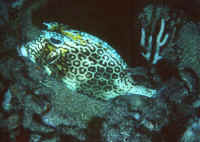 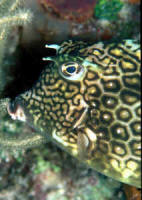
|
Bigger PIX:
The images in this table are
linked to large (desktop size) copies. Click on "framed"
images to go to the larger size. |
%20MD.jpg)

|
| Lactophrys (now
Acanthostracion) quadricornis (Linnaeus 1758),
the Scrawled Cowfish. Note the two horns above eyes; missing in
trunkfish species. A small one (four
inches) and adult one in the Bahamas. |
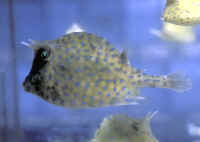 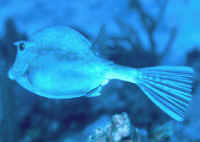
|
Bigger PIX:
The images in this table are linked
to large (desktop size) copies. Click on "framed" images
to go to the larger size. |
|
%20MD.JPG)
%20MD.JPG)
|
|
Acanthostracion quineensis (Bleeker 1865),
the Guinea Boxfish. Eastern Atlantic coast, along Africa's
coast. To seven inches in length.
|
No pic
|
|
Acanthostracion notacanthus (Bleeker 1863),
the Island Cowfish. Eastern Atlantic and mid-islands. To twenty
inches overall length.
|
No pic
|
Genus Lactophrys:
|
Lactophrys bicaudalis (Linnaeus 1758), the
Spotted Trunkfish. Tropical west Atlantic. Yellow to white bodied, with
dark band between the eyes, and another across the back. To nineteen inches.
This one's about fourteen inches, in the Florida Aquarium,
Tampa. More "spotty" appearing as juveniles. As the
juvenile below.
|
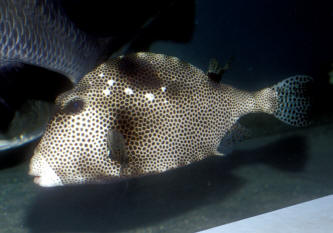
|
|
Lactophrys trigonus (Linnaeus 1758), the
Buffalo Cowfish. Tropical west Atlantic. To about eighteen inches
in length. St. Thomas pic.
|
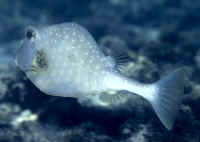
|
Bigger PIX:
The images in this table are linked to large (desktop size) copies.
Click on "framed" images to go to the larger size. |
|
%20MD.jpg)
|
To: part 2,
part 3, part4
|
|

